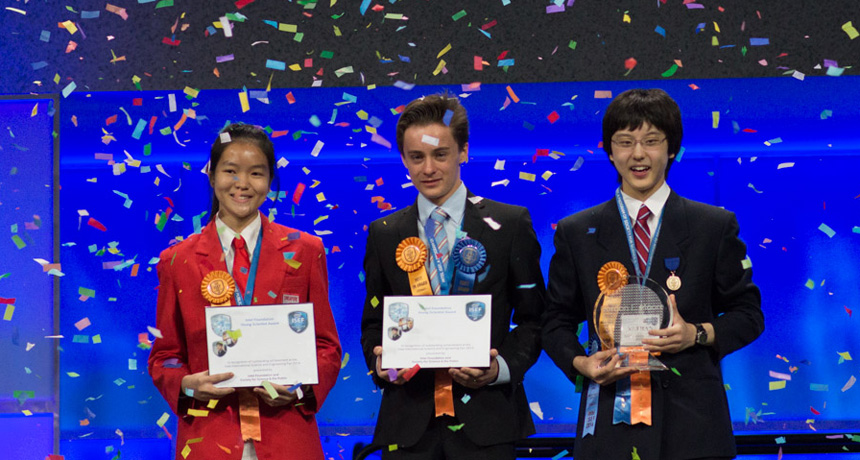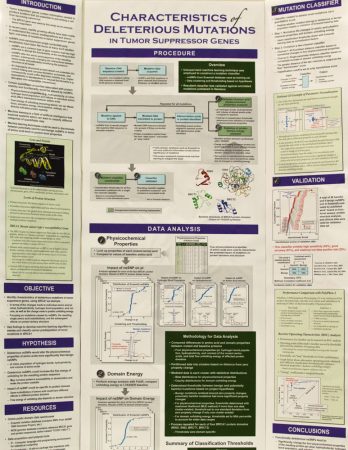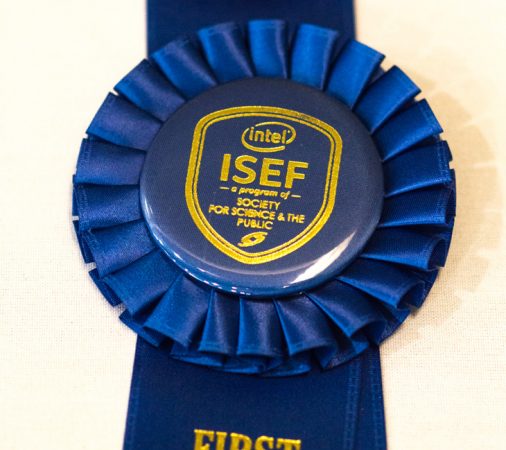Teen’s cancer research scores big at Intel ISEF competition
By analyzing public databases of cancer mutations, a freshman claims Intel ISEF’s top prize

Big winners at this year’s Intel International Science and Engineering Fair include Shannon Lee (left), 17, from Singapore; Lennart Kleinwort (center), 15, from Würzburg, Germany; and Nathan Han (right), 15, from Boston, Mass. Nathan claimed the top prize of $75,000 for his cancer research; Shannon and Lennart each earned $50,000 for their winning projects.
Patrick Thornton/SSP
Share this:
- Share via email (Opens in new window) Email
- Click to share on Facebook (Opens in new window) Facebook
- Click to share on X (Opens in new window) X
- Click to share on Pinterest (Opens in new window) Pinterest
- Click to share on Reddit (Opens in new window) Reddit
- Share to Google Classroom (Opens in new window) Google Classroom
- Click to print (Opens in new window) Print
By Sid Perkins
LOS ANGELES — An innovative statistical analysis of cancer-promoting genes could provide a new roadmap for scientists studying the disease. The technique, which could be applied to other genes as well, earned a 15-year-old researcher the top prize — and $75,000 — here, this week, at the world’s premier high-school science and engineering competition.
Nathan Han of Boston Latin School in Boston, Mass., claimed first prize at this year’s Intel International Science and Engineering Fair, or ISEF. He was one of three young researchers who walked away with prizes worth at least $50,000.
Society for Science & the Public created ISEF in 1950. The Washington, D.C.-based organization still manages the competition. (SSP also publishes Science News for Students.) This annual event attracts some of the world’s most talented young researchers. There were 1,787 finalists this year. They were selected from among the winners at science fairs in more than 70 countries, regions and territories. Altogether, the finalists claimed more than $5 million in awards.

Intel ISEF’s top cash prize is named for Gordon E. Moore, Intel’s cofounder. Nathan Han earned the award this year for studying mutations in genes that normally suppress the growth of tumors. He surveyed public health databases, looking for reports of mutations in a particular gene related to breast cancer. These mutations affect the structure of proteins that should repair cell damage and stifle the growth of cancer. Ultimately, Nathan says, results of this research and other studies like it could identify gene mutations most likely to boost cancer risk.
“There’s a lot of publicly available data out there,” Nathan notes. “This project touches on everything I’m interested in: computer science, biology and statistics.”
Two other young researchers each received Intel Foundation Young Scientist Awards of $50,000.
Lennart Kleinwort earned one for developing a mathematics app for smartphones and electronic tablets. The 15-year-old researcher attends Friedrich-Koenig Gymnasium in Würzburg, Germany. App users can draw shapes on a virtual sheet of graph paper. Then they can move the shapes around, changing their sizes and proportions. Or, they can plot data on the device and instruct it to plot the most accurate fit. His app can be used for both education and research.
The app is designed to work efficiently even on devices with little computing power, Lennart says. Yet the software can handle everything from simple algebra to more complex math, such as calculus. It is suitable for everyone from high school students to scientists, he says. But most of all, the teen continues, “I wanted to create software that would let people have fun with mathematics.”
Shannon Lee, 17, of National Junior College, in Singapore, claimed the other $50,000 prize. She developed an inexpensive material that can be used as an electrode in some types of batteries. Those batteries now typically include an electrode made from a costly mix of platinum and carbon.
Shannon made her new material by heating eggplant at high temperature until it turned into charcoal. Then she soaked this highly porous carbon in potassium hydroxide, an alkaline solution. This dramatically increased the surface area of the material. That provides more places for chemical reactions to occur, she explains. The change could allow engineers to get the same performance found in today’s batteries from a smaller and lower-voltage device.
“In congratulating Nathan, Lennart and Shannon, we join with Intel in seeing great hope in their research and that of all of our Intel ISEF finalists,” says Rick Bates. He’s the interim CEO of SSP.
Best-in-category winners
Seventeen Intel ISEF teams or finalists won “best of category” awards. Each is worth $5,000. Nathan’s project earned first place in the medicine-and-health category. Lennart’s research claimed top prize in math. Shannon took home the top award for energy and transportation.
Other best-of-category winners include:

For behavioral and social science: Michelle Marquez, 15, of the Math and Science High School at Clover Hill, in Midlothian, Va. She studied brain waves in people as they listened to music or other sounds. Her analyses revealed that relatively simple music and sounds seemed to trigger generally positive emotions. In contrast, people who heard complex music or sounds tended to show signs of fear or other negative emotions.
For biochemistry: Ken Aizawa, 17, of Jericho Senior High School in Jericho, N.Y. He analyzed the role of two proteins in boosting the growth of cancer cells. Drug treatment causes concentrations of one protein, called AKT, to drop dramatically. Ken showed that when this happens, levels of another protein — SGK3 — skyrocket. In other tests, he added drugs that decreased levels of both proteins at the same time. This caused cancer cells to die in higher numbers than before. This suggests that targeting both proteins might be a better treatment for certain types of cancer.
For cellular & molecular biology: Joshua Meier, 18, of Academy for the Advancement of Science and Technology in Hackensack, N.J. He studied how to prevent premature aging in certain types of stem cells. Stem cells are cells that can mature into any of many different types. Such cells could someday be used to treat a variety of common age-related diseases. Joshua’s tests identified 16 genes that have been linked with early aging of these cells. Targeting these genes might keep the stem cells younger longer. If that works, doctors might one day be able to prevent or delay ailments such as Parkinson’s disease, Alzheimer’s disease or diabetes.
For chemistry: Tai Hei Chan, 18, and Er Hai Fang, 17, of King’s College in Hong Kong, China. They developed a faster, cheaper and less invasive test for a kidney ailment known as chronic renal failure. The old test provides results in about 3 days. Their new one takes only 10 minutes.
For computer science: Yue Yao, 17, of a high school affiliated with Shanghai Jiao Tong University in China. He used three-color combinations of lights transmitted over fiber-optic cables as the basis for new computing techniques. Most computers use “1”s and “0”s transmitted over wires, which can heat up, wasting energy. The new methods could make computers faster and more efficient, he says.
For earth science: Yu-Hsin Chen, 17, of the Taipei First Girls High School in Chinese Taipei. Her analyses suggest that the average intensity of typhoons (hurricanes) in the western North Pacific has increased by about 10 percent in the past 20 years. The largest factor boosting their strength, she found, is an increase in the thickness of the layer of warm surface water throughout that region.
For engineering: electrical & mechanical: Sarah Galvin, 18, of Corona del Sol High School in Tempe, Ariz. She improved the performance of certain types of electronic components. Those devices have typically been built on a disk made from magnesium oxide. Its crystal structure was long presumed to offer the best match for the circuits laid down atop them. But magnesium oxide is expensive to work with. Sarah’s tests suggest that by making the base of these devices from silicon dioxide, the circuitry would be much cheaper. (Silicon dioxide is now used for many computer chips.) What’s more, such circuits perform almost 9 percent better, she reports.
For engineering: materials & bioengineering: Harry Paul, 17, of the Paul D. Schreiber High School in Port Washington, N.Y. He developed a device to straighten and stabilize the spines of children born with scoliosis, an abnormally curved backbone. Correcting the condition typically requires a dozen or more surgeries before adulthood. But Harry invented a titanium-alloy implant that can extend as a patient grows. That might reduce a patient’s surgeries to five or fewer. One additional benefit: It would cut the amount of scar tissue that forms as well as the chance of surgery-related infections.
For environmental management: Faye Jong, 15, of Sekolah Menengah Kebangsaan Batu Lintang in Kuching, Malaysia. She figured out how to use biowastes, such as fruit peels and discarded tea bags, as eco-friendly replacements for the synthetic dyes now used to color fabric. Some alternatives, such as mangosteen peels, worked just as well as chemical dyes, she found. This kind of recycling would keep many biowastes out of landfills. The natural products could also cut the need for many chemicals and reduce pollution, Faye suggests.
For environmental sciences: Perry Alagappan, 17, of Clear Lake High School in Houston, Texas. He invented a filter that uses carbon nanotubes to remove toxic metals from water. Such pollutants include lead, cobalt and cadmium. The filter can remove more than 99 percent of these metals from even very polluted water. And unlike other types of filters, he notes, the new device can be reused after washing it in industrial-strength vinegar.
For microbiology: Logan Collins, 17, of Fairview High School in Boulder, Colo. He developed a way to use cellular features called plasmids to deliver genes into bacteria that will stunt the microbes’ growth. The technique could be used as a treatment against bacterial infections. This treatment doesn’t use drugs. As such, Logan says, this approach to fighting germs could overcome the problem of resistance that occurs with many antibiotics.
For physics and astronomy: J. Chapman Caddell, 16, of Stevenson School in Pebble Beach, Calif. He showed that lopsided grooves on the inner surface of a pipe can act as a non-mechanical pump for boiling fluids. Those oddly shaped grooves interact with the layer of steam that forms on a pipe’s inner surface. They push any droplets in the pipe more in one direction than in another. Adding those grooves to pipes carrying water or other fluid through a nuclear reactor could help cool it in case of an emergency situation, such as when electrical pumps fail, Chapman says.
For plant sciences: Yi-Hsuan Huang, 17, of the Taipei Municipal Jianguo High School in Taipei City, Chinese Taipei. A protein found in all plants and animals affects flowering in a plant called Arabidopsis. Previously, scientists had suspected that the protein, called bZIP16, affected only the sprouting of the plant’s seeds. Yi-Hsuan showed, though, that it does much more. Plants that couldn’t make bZIP16 bloomed about 7 days later than plants that made normal amounts of the protein, he found. Plants that made excessive amounts of the protein bloomed earlier than usual. That showed the protein also helps control when a plant prepares for reproduction.
Intel ISEF finalists earned a slot in L.A. by besting their competitors at 435 local and regional science fairs affiliated with ISEF — an inspiring feat.
“Not only are they working to discover solutions for society’s challenges,” says SSP’s Bates, “they importantly serve as an inspiration for younger students and encourage them to become involved in the amazing world of hands-on science and engineering.”
Power words
antibiotic A germ-killing substance prescribed as a medicine (or sometimes as a feed additive to promote the growth of livestock). It does not work against viruses.
app Short for application, or a computer program designed for a specific task.
Alzheimer’s disease An incurable brain disease that can cause confusion, mood changes and problems with memory, language, behavior and problem solving. No cause or cure is known.
Arabidopsis A small flowering plant related to cabbage and mustard. It is commonly used in genetic studies of plants — so much so that it is sometimes considered to be “the lab rat of the plant world.”
battery A device that can convert chemical energy into electrical energy.
cancer Any of more than 100 different diseases, each characterized by the rapid, uncontrolled growth of abnormal cells. The development and growth of cancers, also known as malignancies, can lead to tumors, pain and death.
chronic renal failure The late stages of progressive, gradually worsening kidney disease.
computer science The scientific study of the principles and use of computers.
diabetes A disease where the body either makes too little of the hormone insulin (known as type 1 disease) or ignores the presence of too much insulin when it is present (known as type 2 diabetes).
electrode (in chemistry) Materials that serve as an anode or cathode, attracting negatively or positively charged particles. Or things that serve as electric conductors through which current leaves or enters something else.
engineering The field of research that uses math and science to solve practical problems.
fiber optics The use of thin, flexible fibers of glass (known as optical fibers) or other transparent solids to transmit light signals, chiefly for telecommunications.
filter (in chemistry and environmental science) A device which allows some materials to pass through but not others, based on their size or some other feature.
giardiasis Commonlyknown as “beaver fever,” this disease is caused by a microbe that inhabits the digestive tract of a variety of wild and domestic animals. One major symptom of the disease is diarrhea, so the parasite is easily spread when water supplies become contaminated with the microbe.
microbe Short formicroorganism. (see microorganism)
microorganism A living thing that is too small to see with the unaided eye, including bacteria, some fungi and many other organisms such as amoebas. Most consist of a single cell.
mutation Some change that occurs to a gene in an organism’s DNA. Some mutations occur naturally. Others can be triggered by outside factors, such as pollution, radiation, medicines or something in the diet. A gene with this change is referred to as a mutant.
nano A prefix indicating a billionth. It’s often used as an abbreviation to refer to objects that are a billionth of a meter long or in diameter.
Parkinson’s disease A disease of the brain and nervous system that causes tremors and affects movement, memory and mood.
plasmid A small circular loop of DNA that is separate from the main chromosomal DNA of bacteria.
pluripotent A term that means having many possibilities. In medicine, pluripotent is an adjective used to describe a type of stem cell that can mature into any other type of cell in the body.
porous Filled with pores, or holes.
proteins Compounds made from one or more long chains of amino acids. Proteins are an essential part of all living organisms. They form the basis of living cells, muscle and tissues; they also do the work inside of cells. The hemoglobin in blood and the antibodies that attempt to fight infections are among the better known, stand-alone proteins.Medicines frequently work by latching onto proteins.
resistance (as in drug resistance) The reduction in the effectiveness of a drug to cure a disease, usually a microbial infection.
scoliosis A medical condition in which a person’s spine is abnormally curved from side to side, sometimes giving the backbone an “S” shape when seen from the front or rear.
silicon A nonmetal, semiconducting element used in making electronic circuits. Pure silicon exists in a shiny, dark-gray crystalline form and as a shapeless powder.
smartphone A cell (or mobile) phone that can perform a host of functions, including search for information on the Internet.
statistics The practice or science of collecting and analyzing numerical data in large quantities and interpreting their meaning. Much of this work involves reducing errors that might be attributable to random variation. A professional who works in this field is called a statistician.
stem cell A “blank slate” cell that can give rise to other types of cells in the body. Stem cells play an important role in tissue regeneration and repair.
synthetic (as in materials) Materials created by people. Many have been developed to stand in for natural materials, such as synthetic rubber, synthetic diamond or a synthetic hormone. Some may even have the same chemical structure as the original.
tablets (in computing) A small, hand-held computer that can connect to the Internet and that users can control using a touch screen. An Apple iPad, Samsung Galaxy and Amazon Kindle Fire are all examples of tablets.
typhoon A cyclone that forms in and affects the tropical areas of the Pacific Ocean. A typhoon is exactly the same as a hurricane; it just forms in a different geographical region.
voltage A force associated with an electric current that is measured in units known as volts. Power companies use high-voltage to move electric power over long distances.







